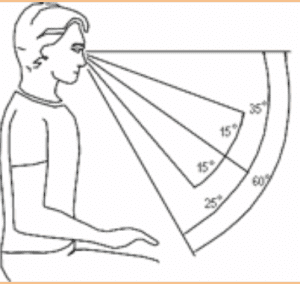Conventional advice has been that the top of the monitor should be located at, or just below, eye level. Is this correct?
VERTICAL HEIGHT – MONITOR LOCATION
New evidence shows that this is a good position if you are looking at things in the distance, but for close objects our eyes prefer a much more downward gaze angle. Anywhere from 20º to 50º below the horizontal is now being recommended.
Where do you hold a book to read?

The lower the gaze angle the better your eyes can focus especially when things are close like reading. This is because the eyes converge (turn inwards) when we need to see close and they diverge when we look up so that we can see things in the distance. So we are basically looking down our nose to read.
Optometrists also place the reading lens towards the bottom of the spectacles, to allow this focus to occur down the nose.
Also, if we use a downward gaze angle, the eye lids will cover more of your eye and thus decrease the amount of drying of the eyes when reading your screen. When you look straight ahead or upwards your eye lids open more and thus increased drying of the eyes can occur.

So if you lower your monitor as close to the desk surface as possible, you will achieve the downward gaze angle.
You may think this will place more strain on the back of the neck, however this has not been found to be the case, as our eyes have a great range of vision zone between the desk and the monitor. With the monitor down lower means you don’t need you to move your head to do this. However if you watch someone who has placed their monitor up high (stacked it with reams of paper etc), you will see them repeatedly raise and lower their head to view their monitors. This actually places more strain on the neck.
So what’s the evidence* for Downward Gaze Angle and Lowering the Monitor?
- Improve our eyes ability to accommodate and converge
- Reduces headache and eyestrain
- Reduces dry eyes – less of your eyeball exposed to the atmosphere
- Gives us more options for neck movement and postural change
- Does NOT increase muscle activity in the neck and upper back
- Improves our productivity by 10% when the monitor is 35º below the horizontal compared to eye level.
EYE TO SCREEN DISTANCE

Place your arm straight out in front of you with your fingers stretched. Your screen should be at least this distance away from you. Farther away is also OK.
The most important thing to check is that you can read the monitor without having to change your head and neck position.
Many people I assess have a tendency to poke their head forward. If you find yourself leaning forward or poking your head forward, it means you probably are having problems with you focus. Either bring the monitor closer; increase the size of your font; or visit your local optometrist for a visual check-up.
MONITOR TILT ANGLE.
Hold a book or some reading material in front of you. Notice how the top of the document is held further away than the bottom.
Now try reading the document when it is vertical. Notice that the closer the top of the document moves closer to you, the more uncomfortable it becomes to read. This is because objects we see in the upper part of our peripheral vision are usually further away (using our long vision) and objects we see in the bottom part are usually closer (using our short vision). So our visual system has developed to perform best when the visual plane tips away from us at the top.
Research shows that keeping the monitor low and tipped back leads to the least increase in neck discomfort.
N.B. If you now notice some glare on your screen it is best to find the source and remove or relocate this.
References
Ankrum, D. R., & Nemeth, K. J. (1995). Posture, Comfort, and Monitor Placement. Ergonomics in Design, 3(2), 7–9.
The above summary and review of current research is from Guidelines for Monitor Placement by Dennis R Ankrum CIE


